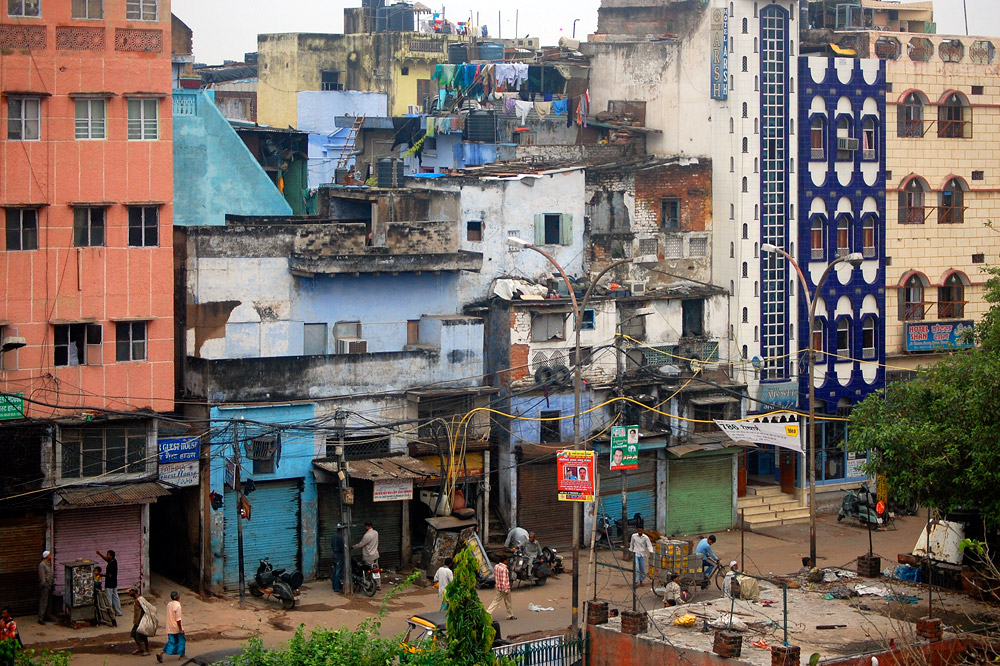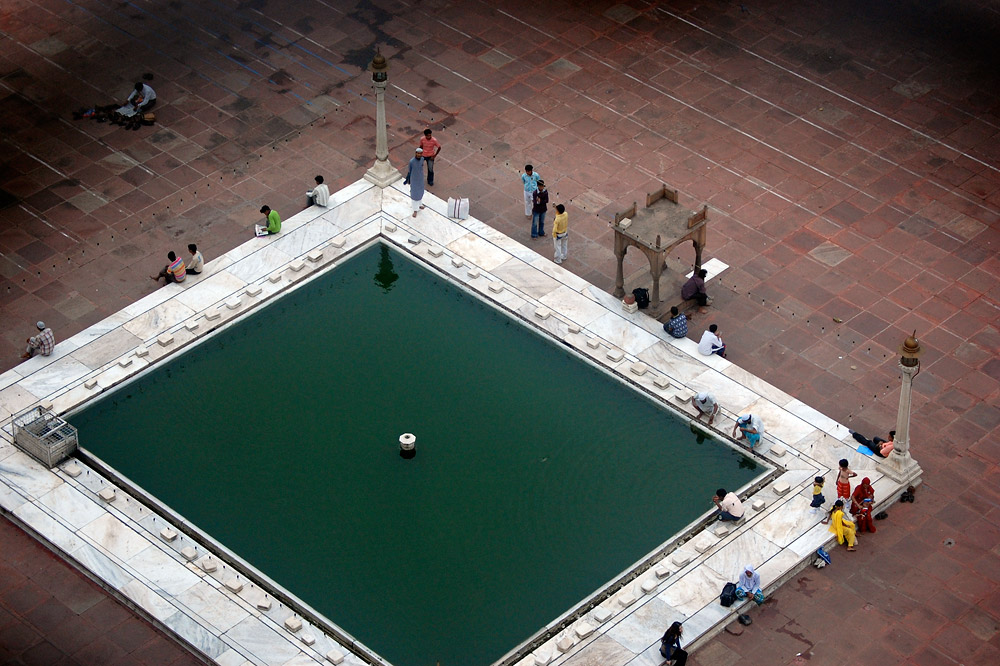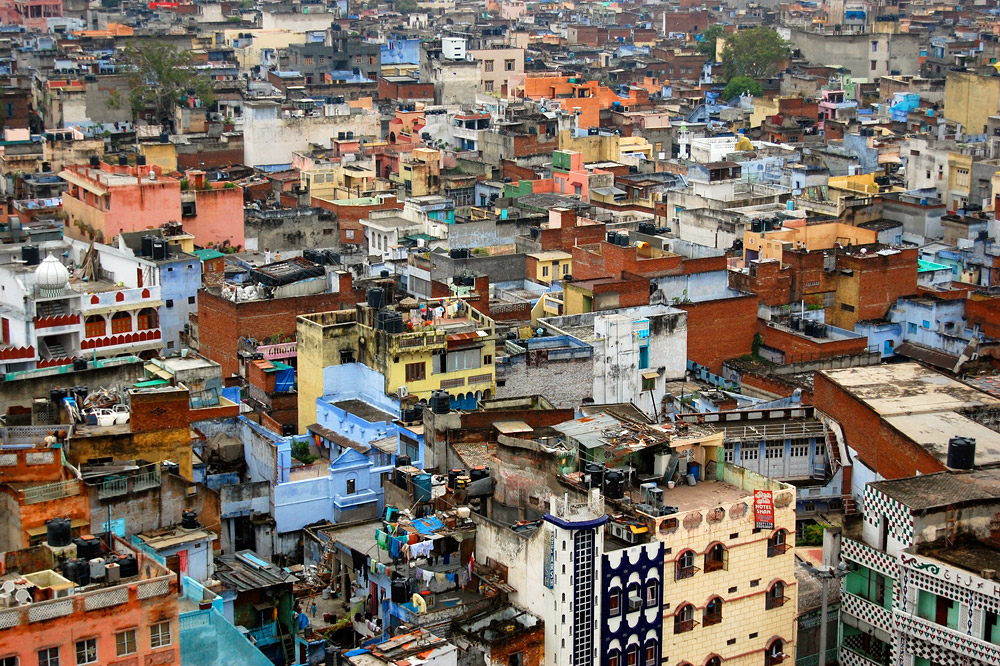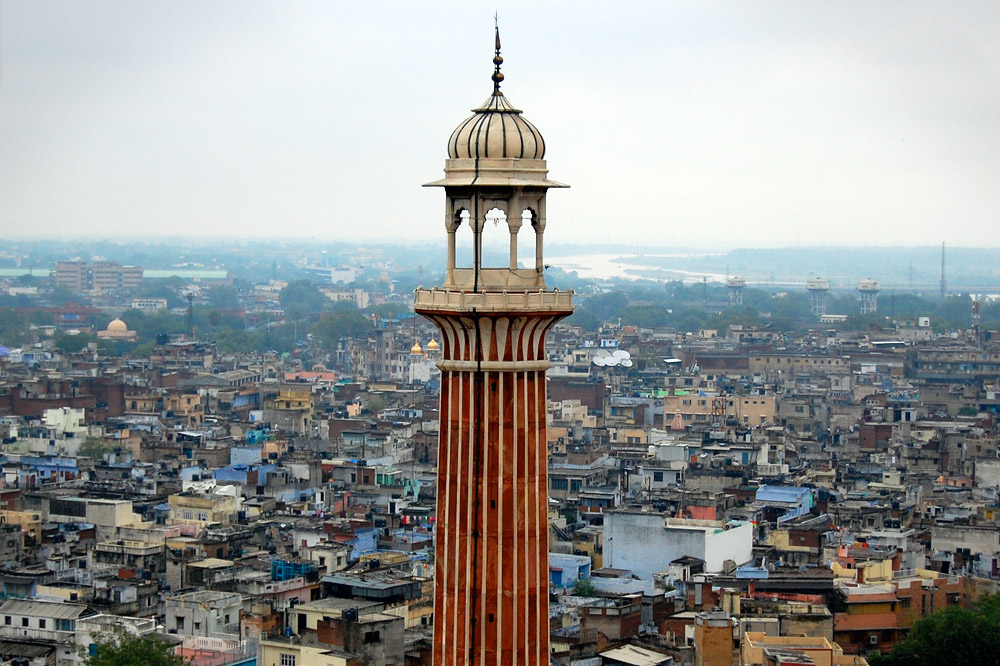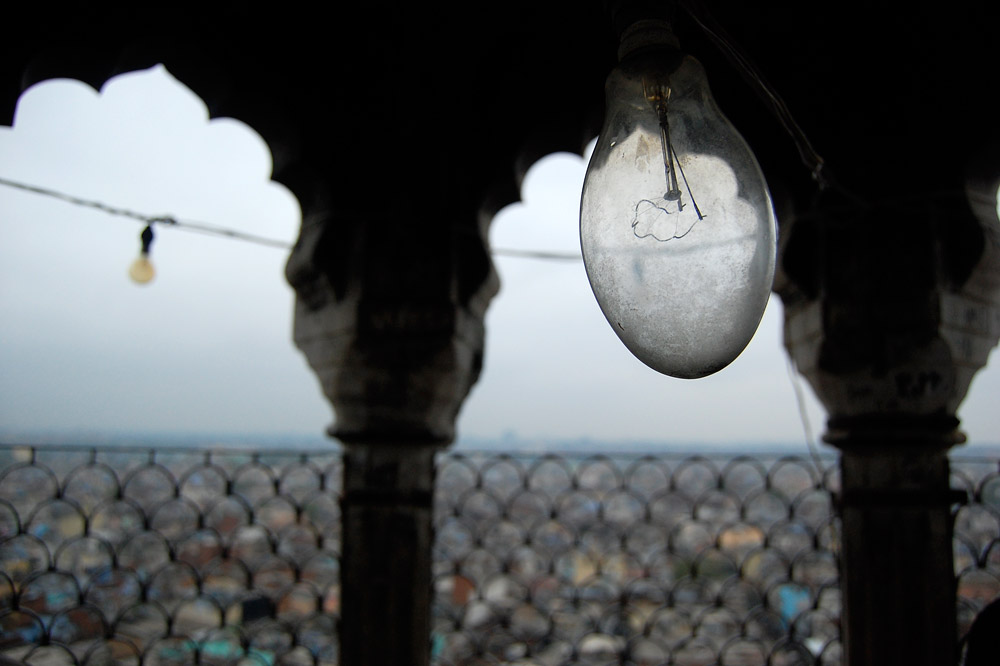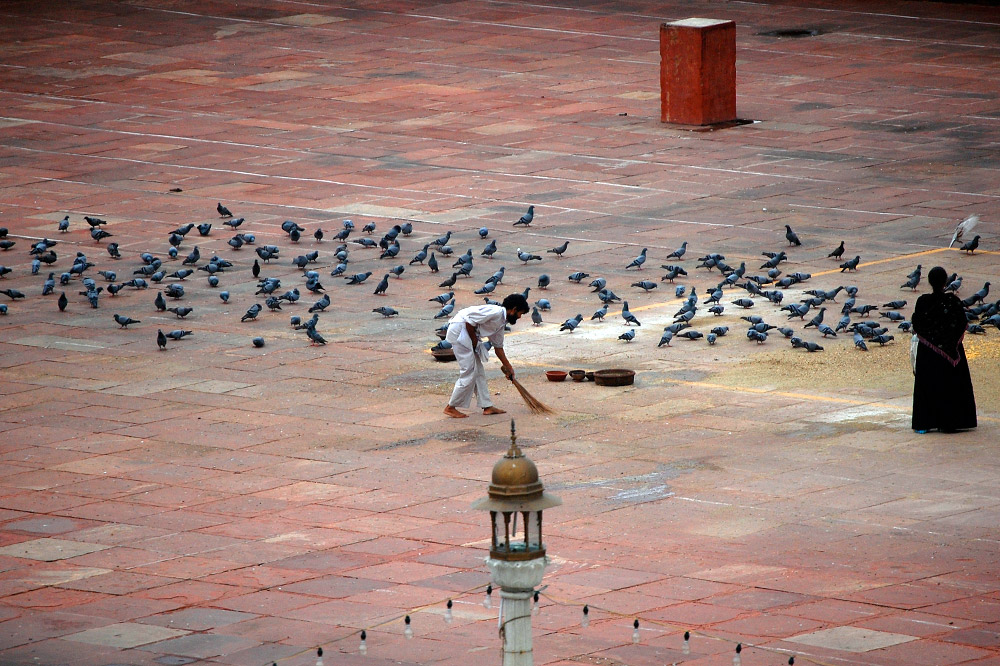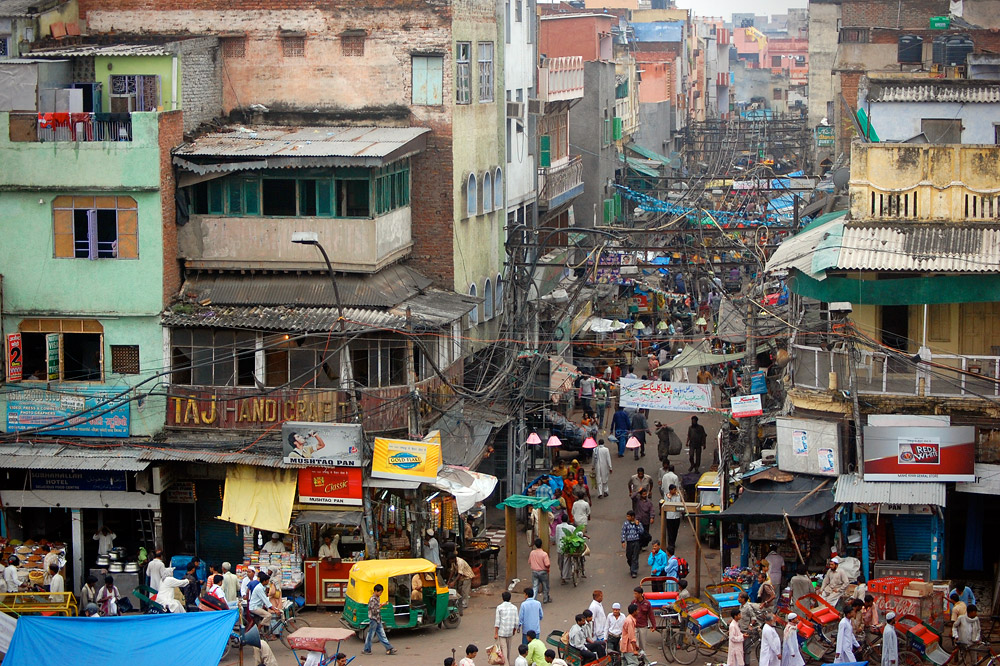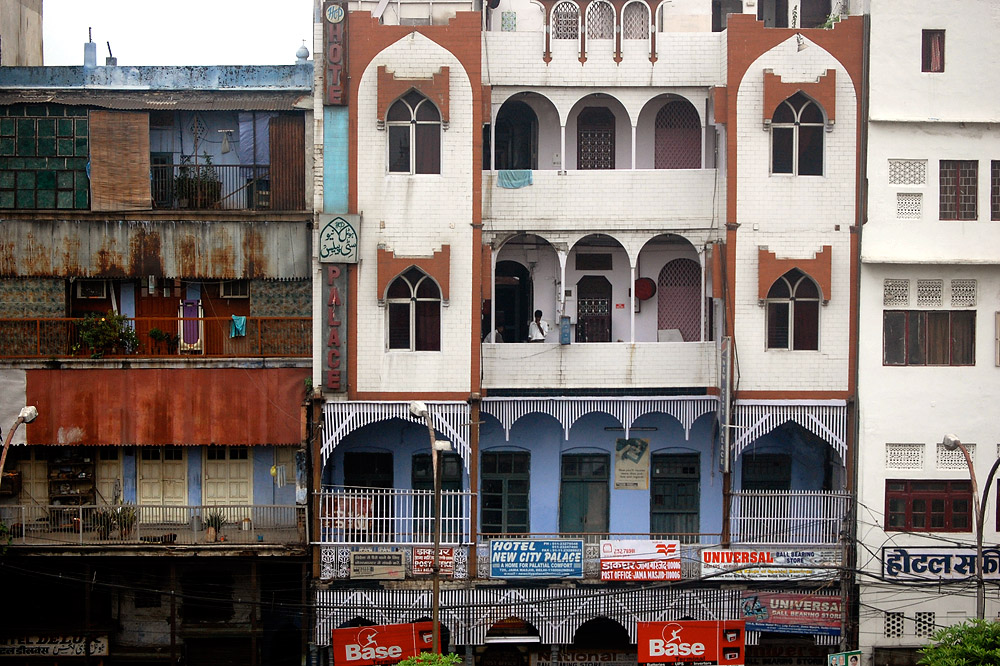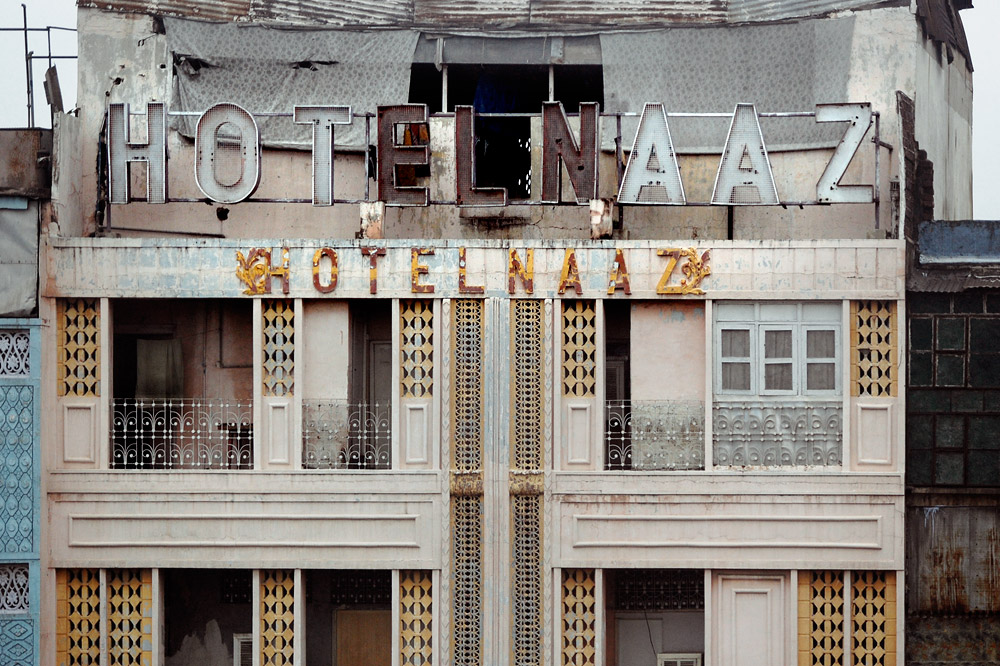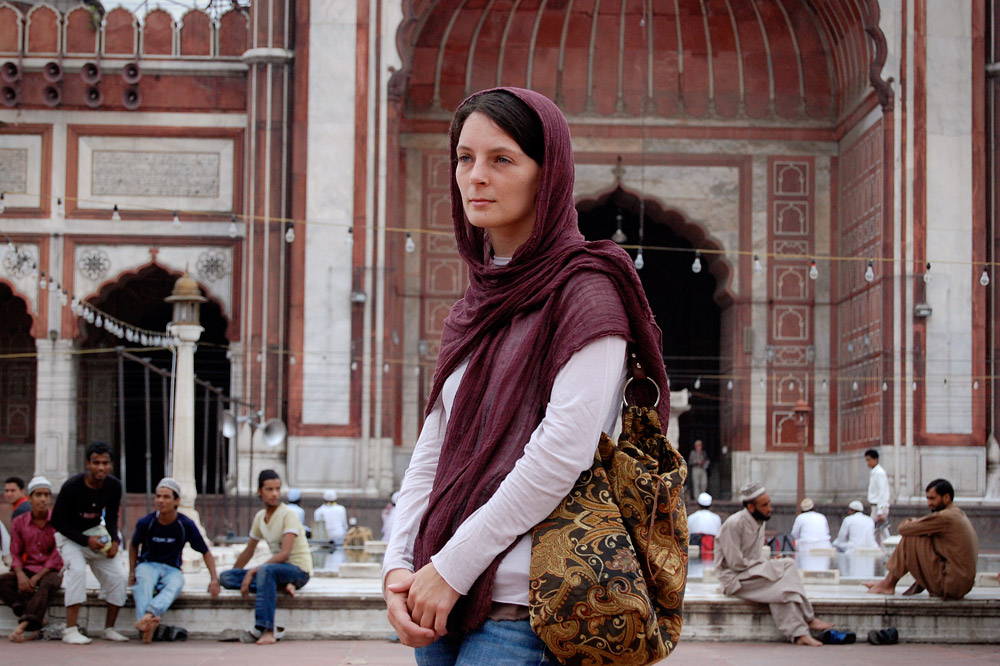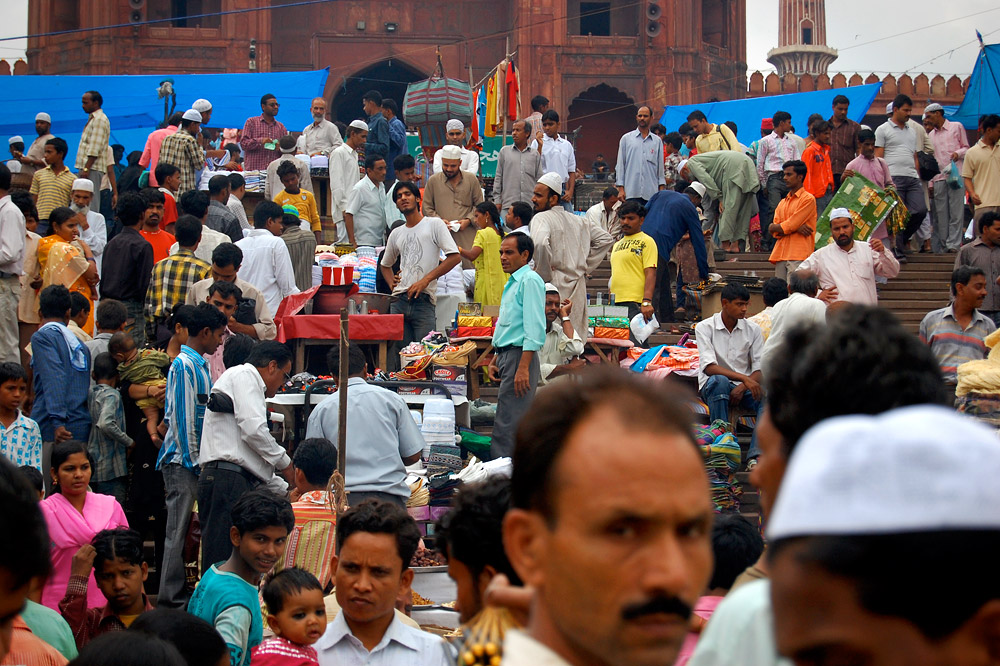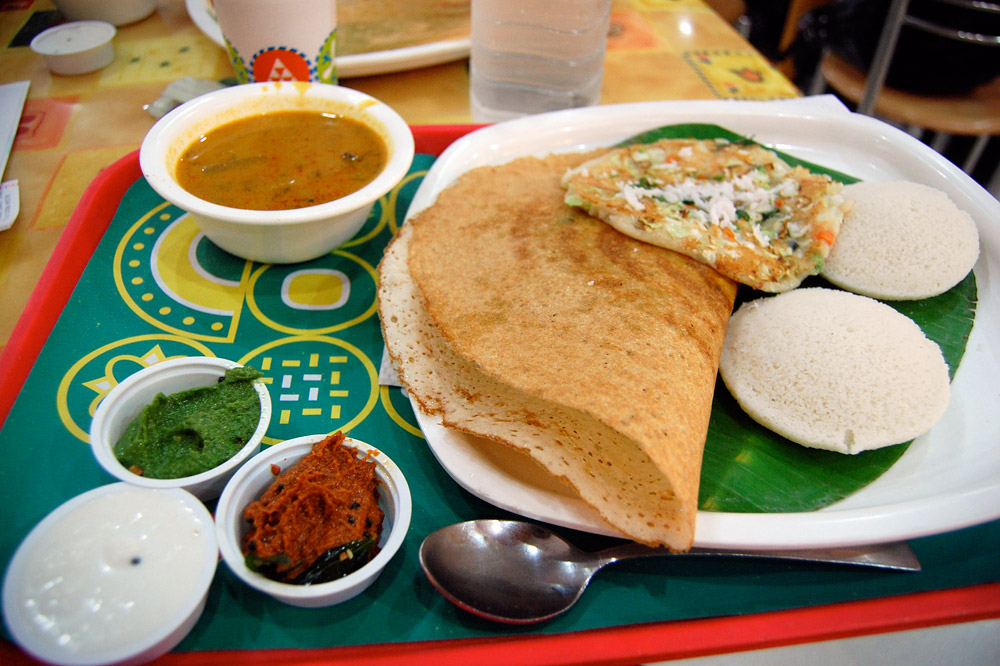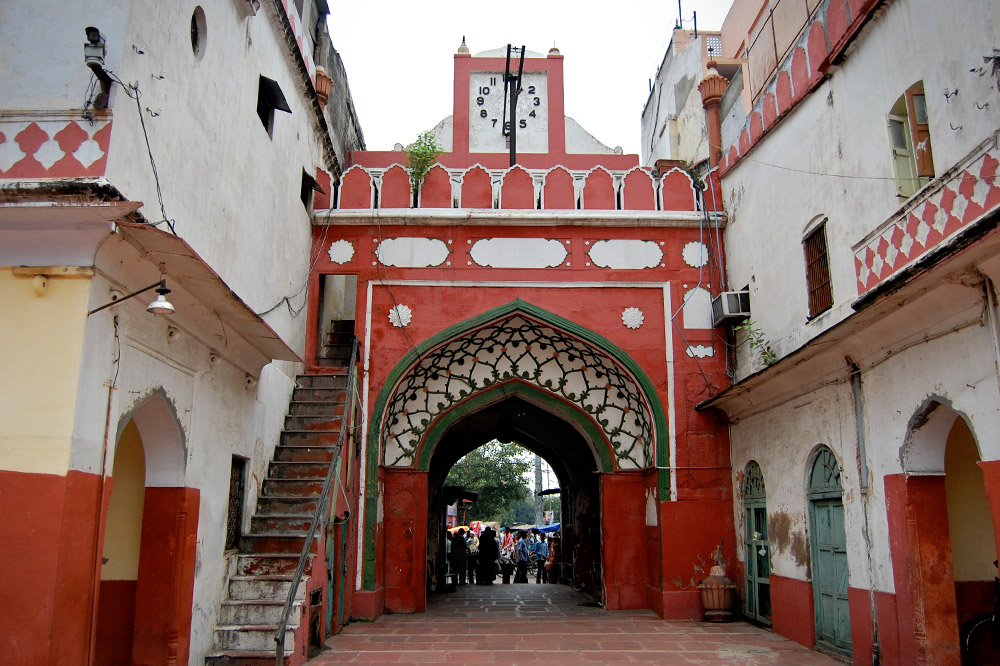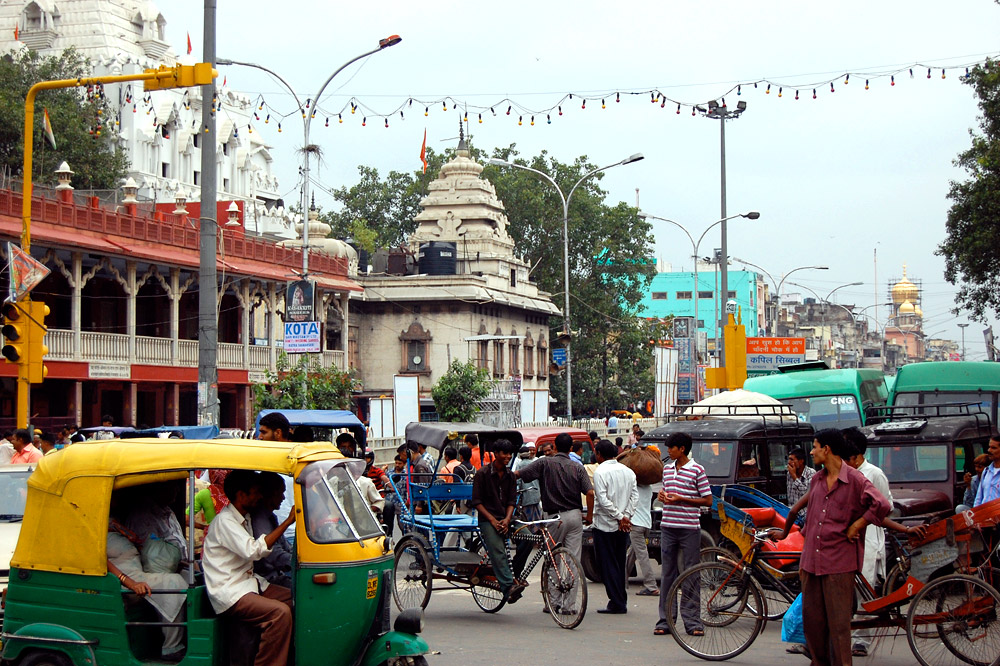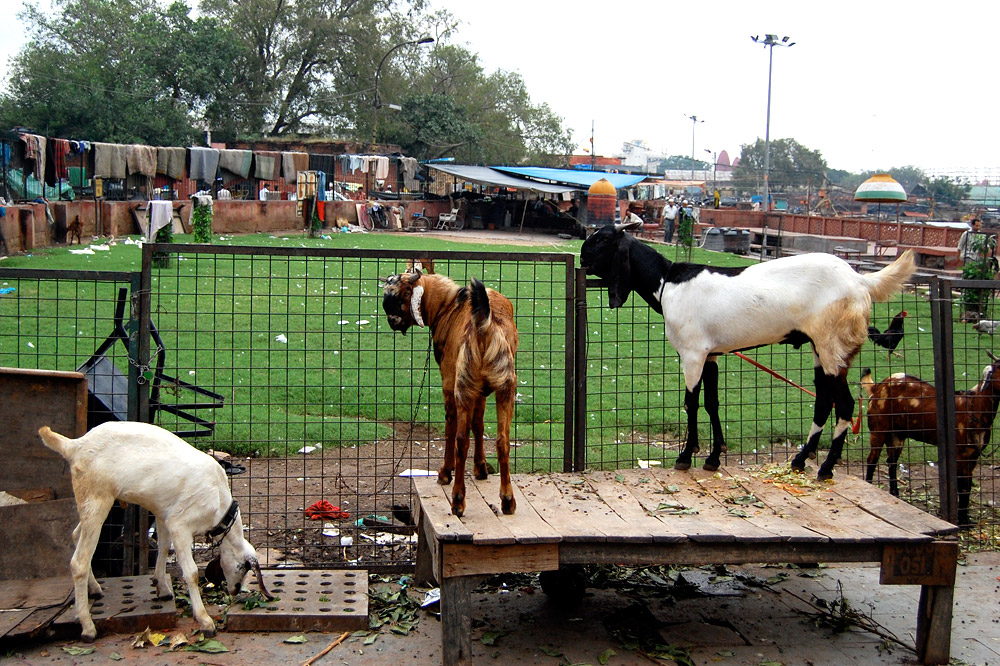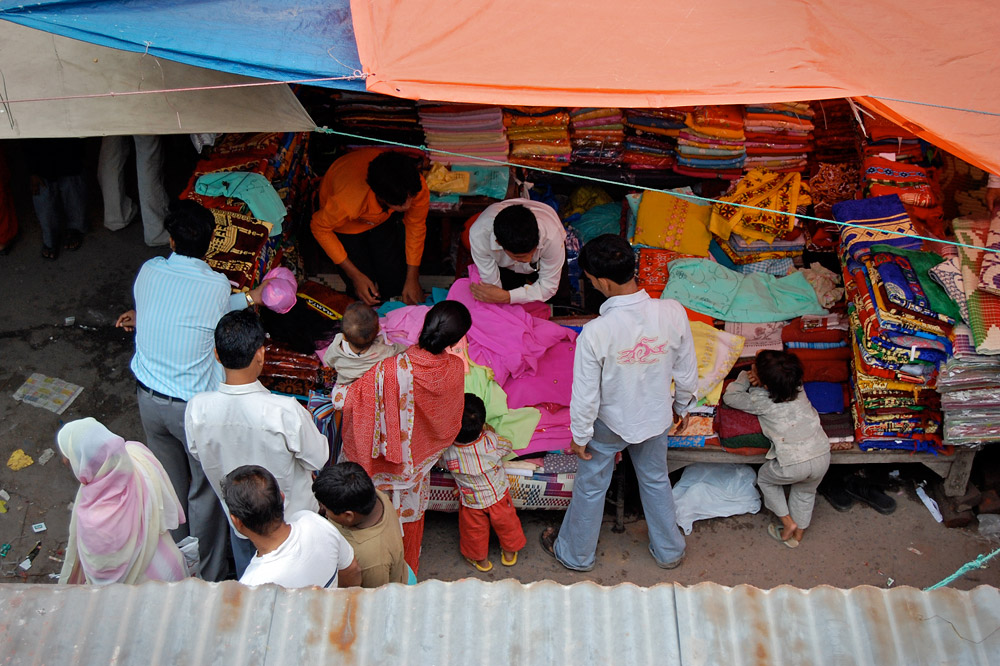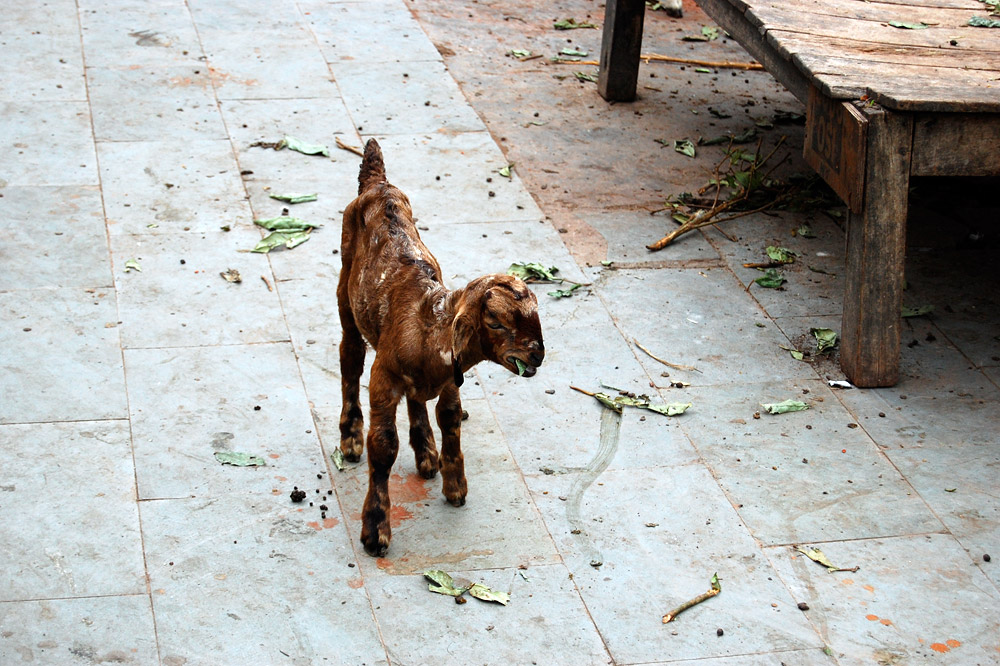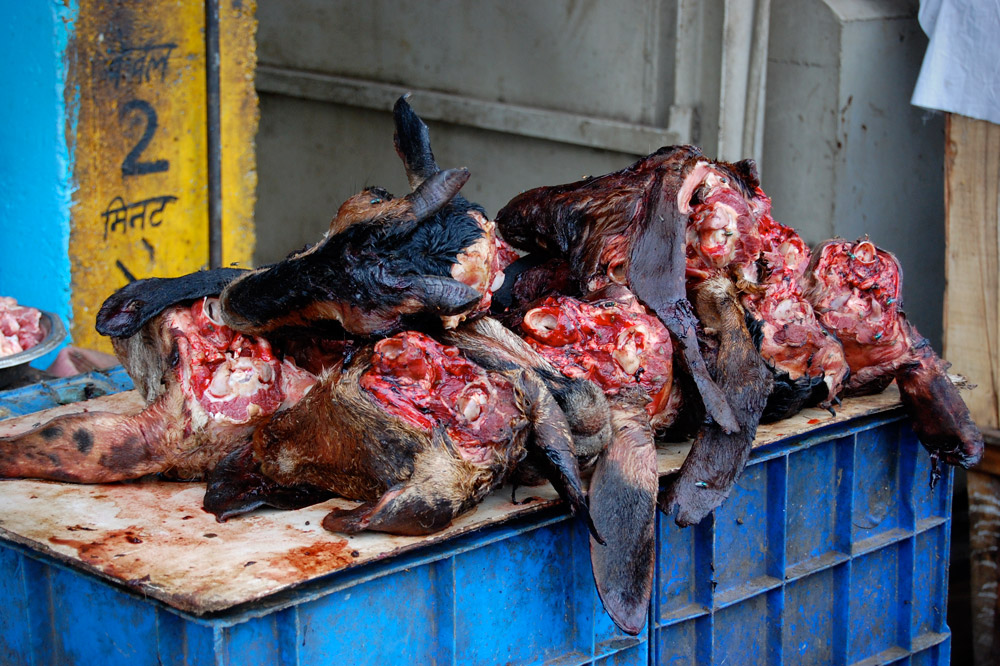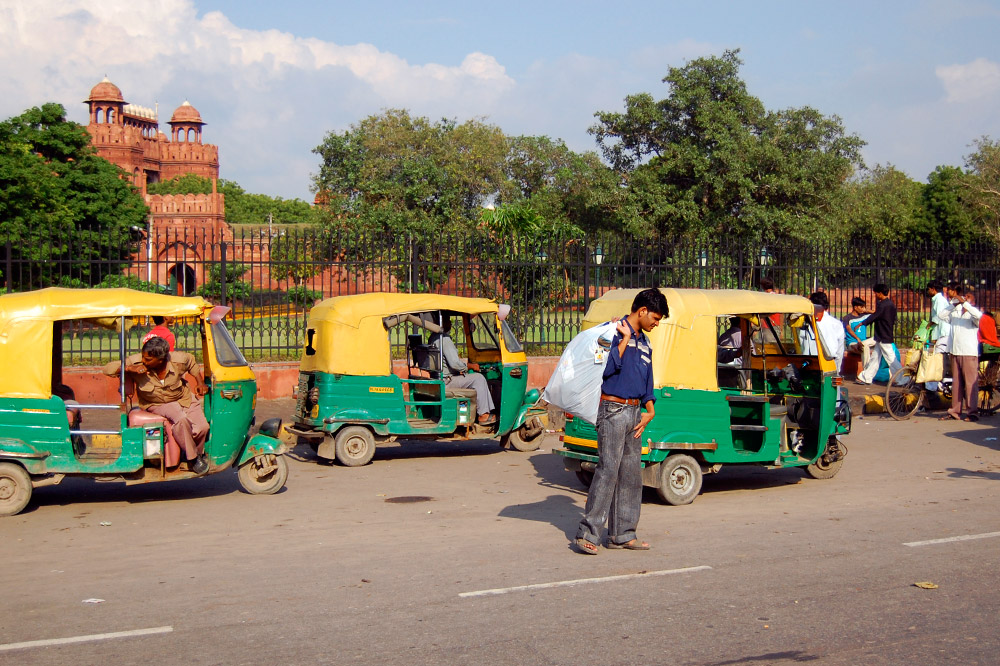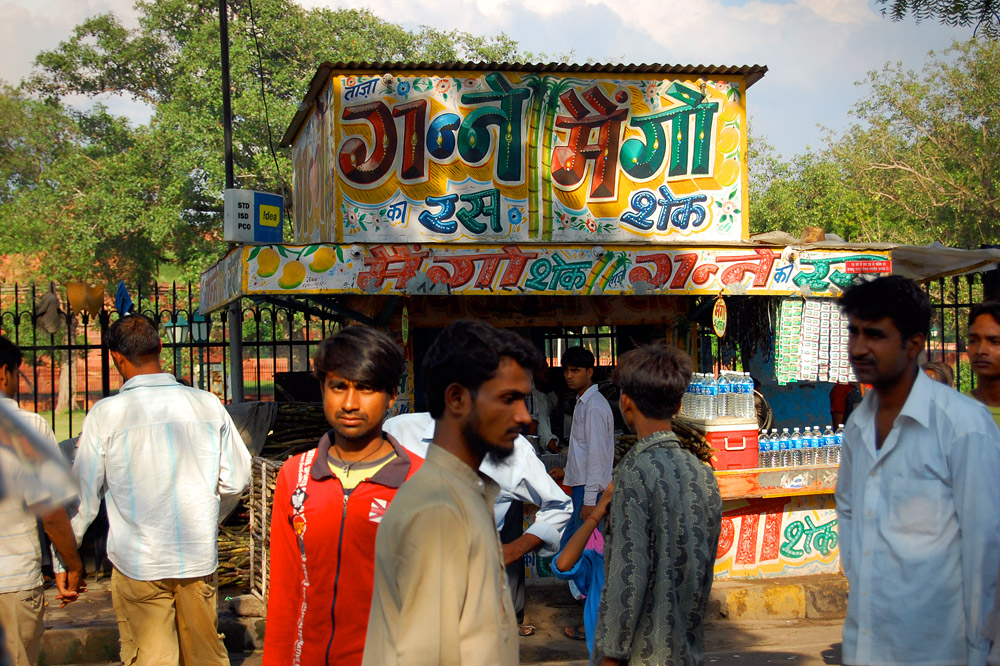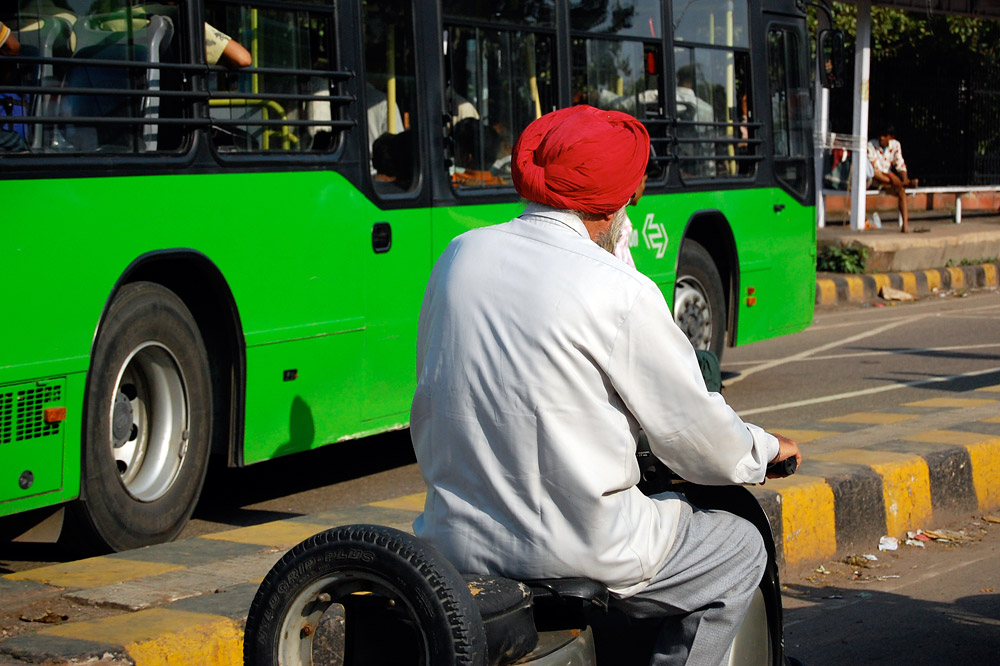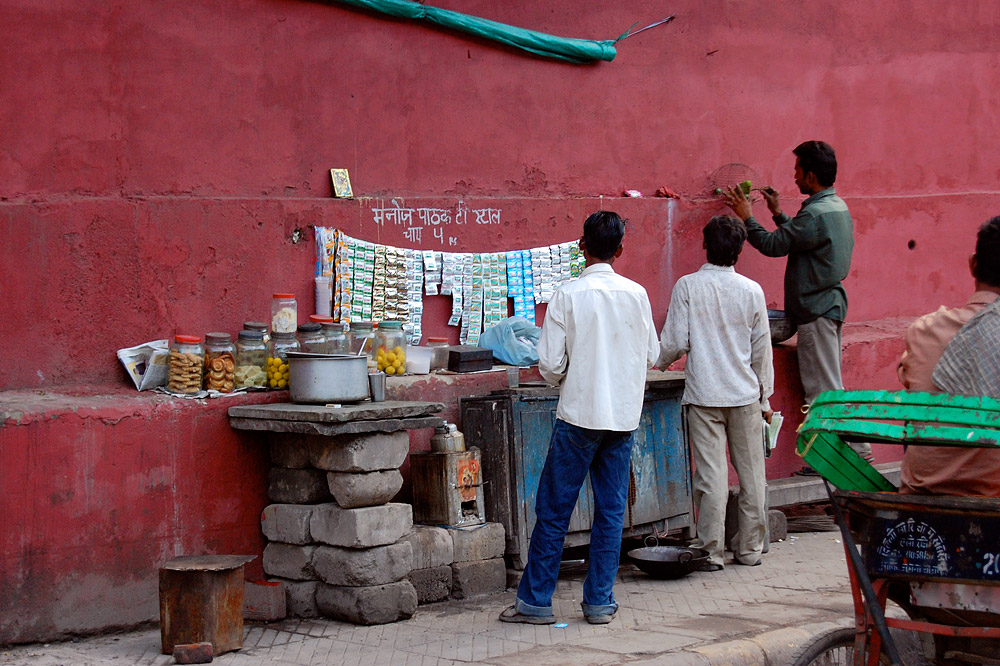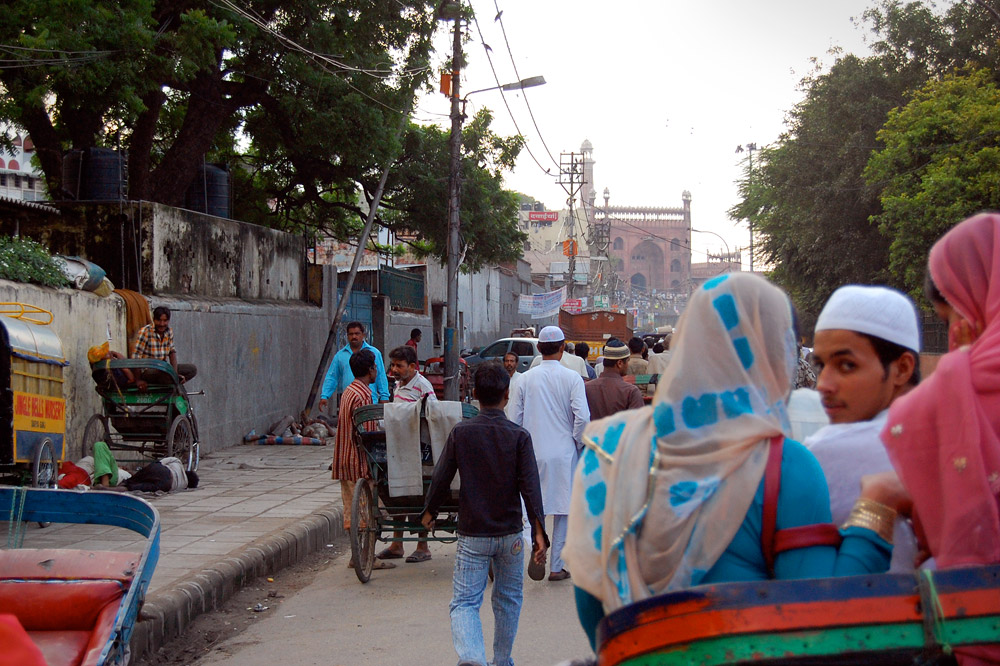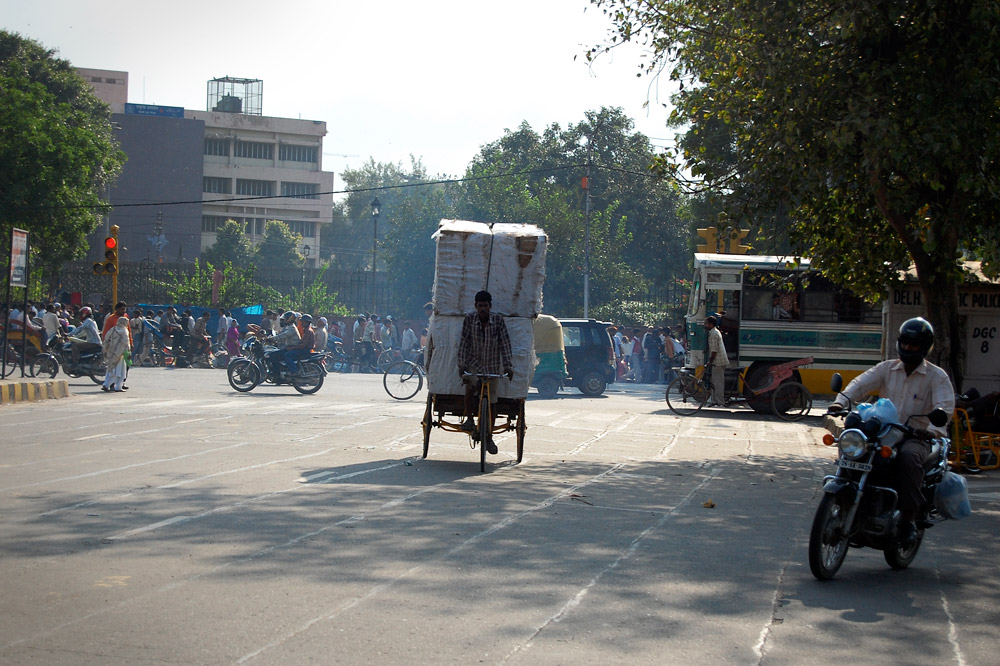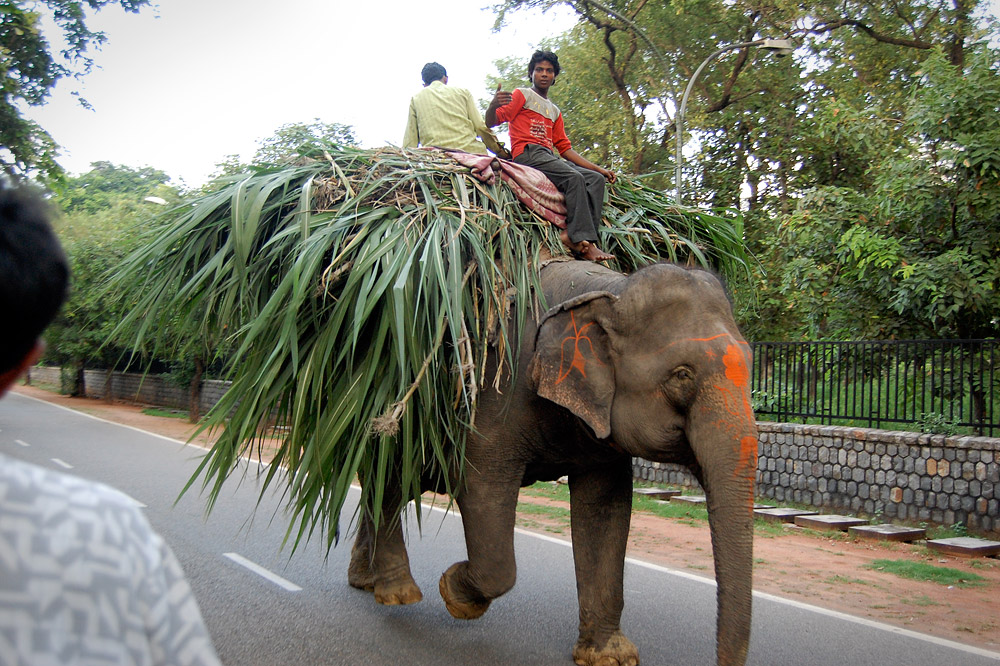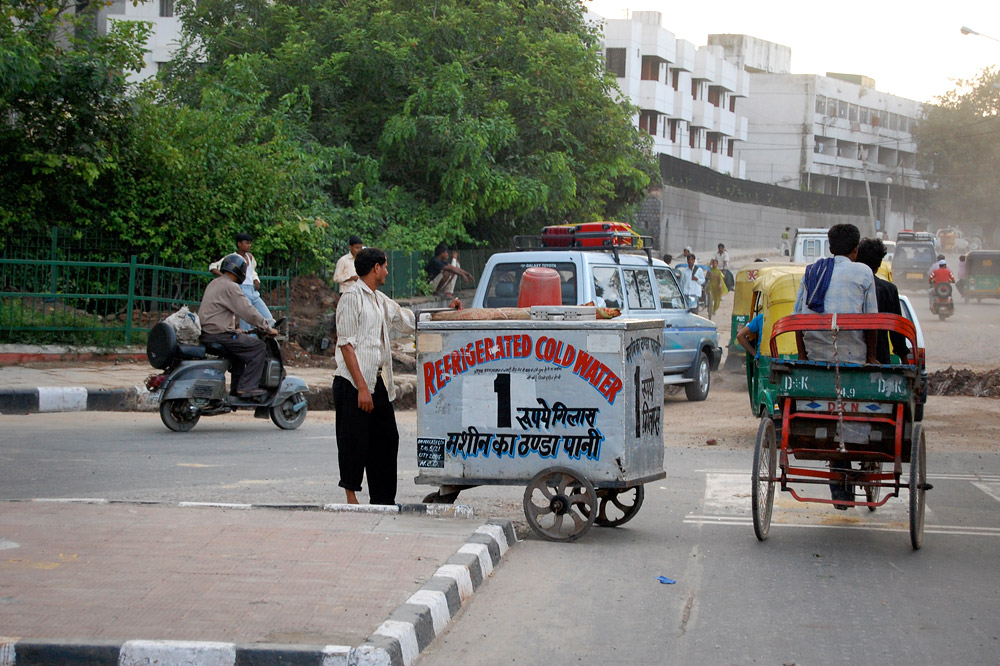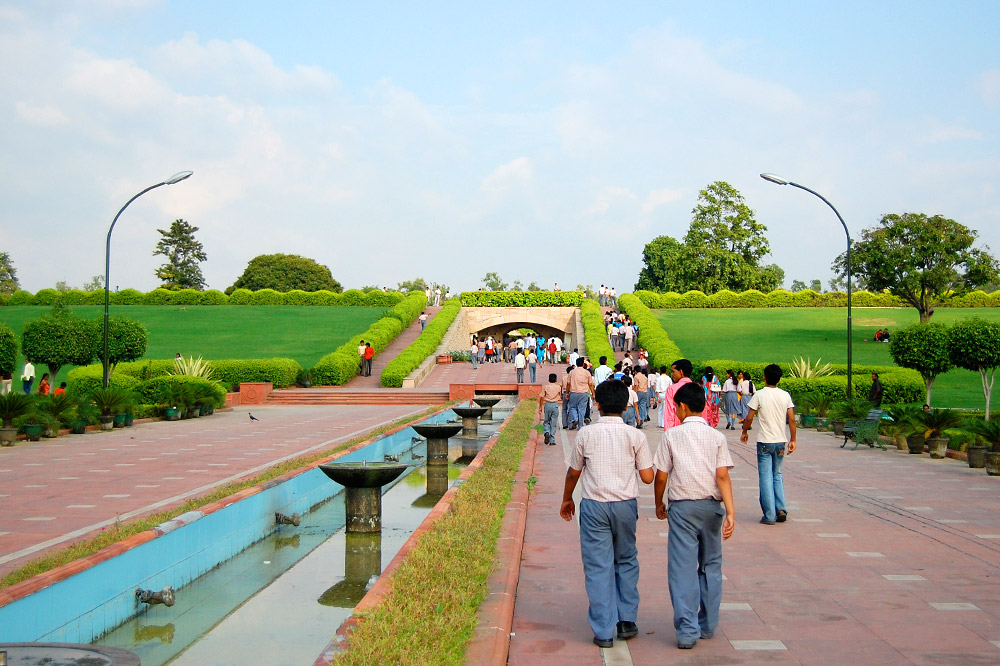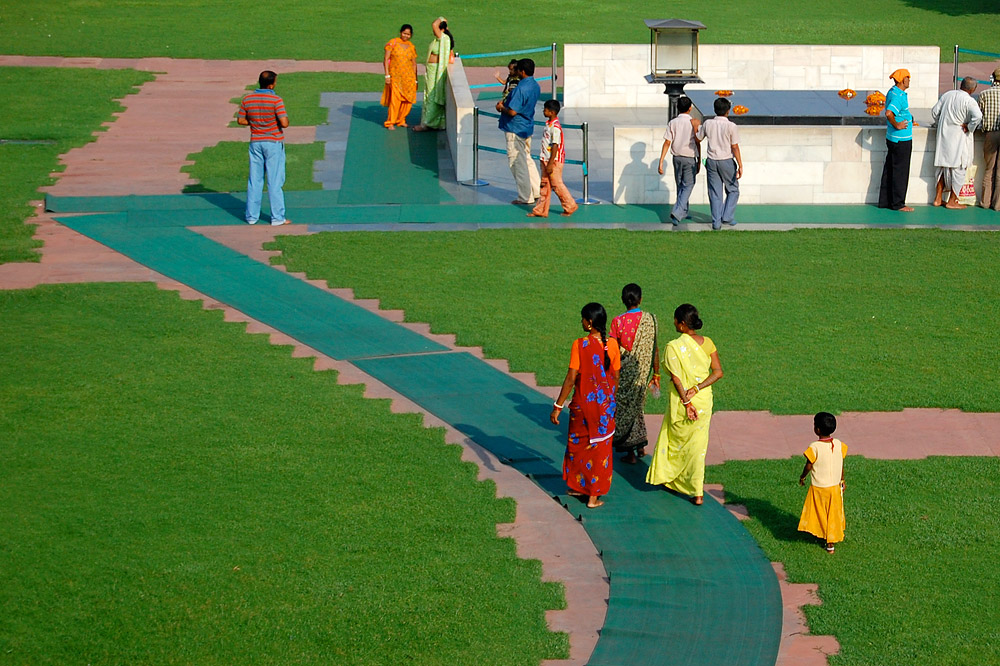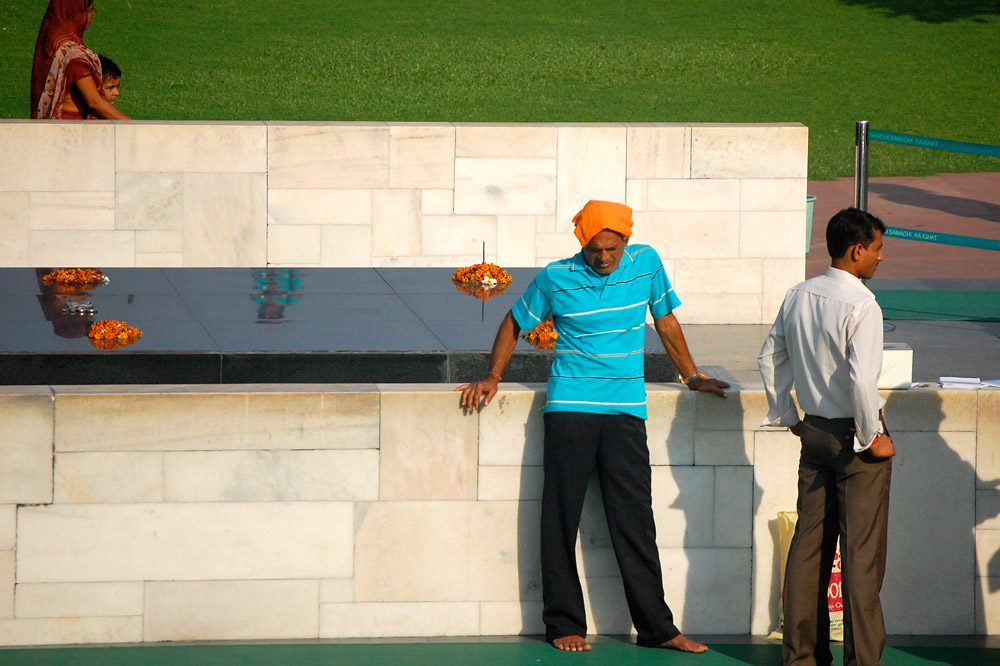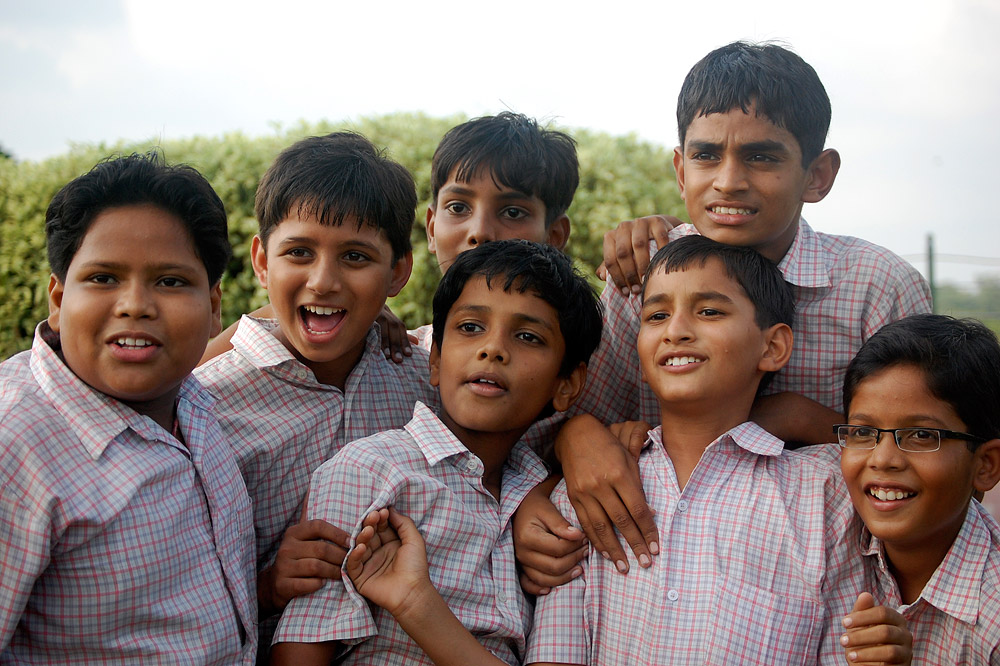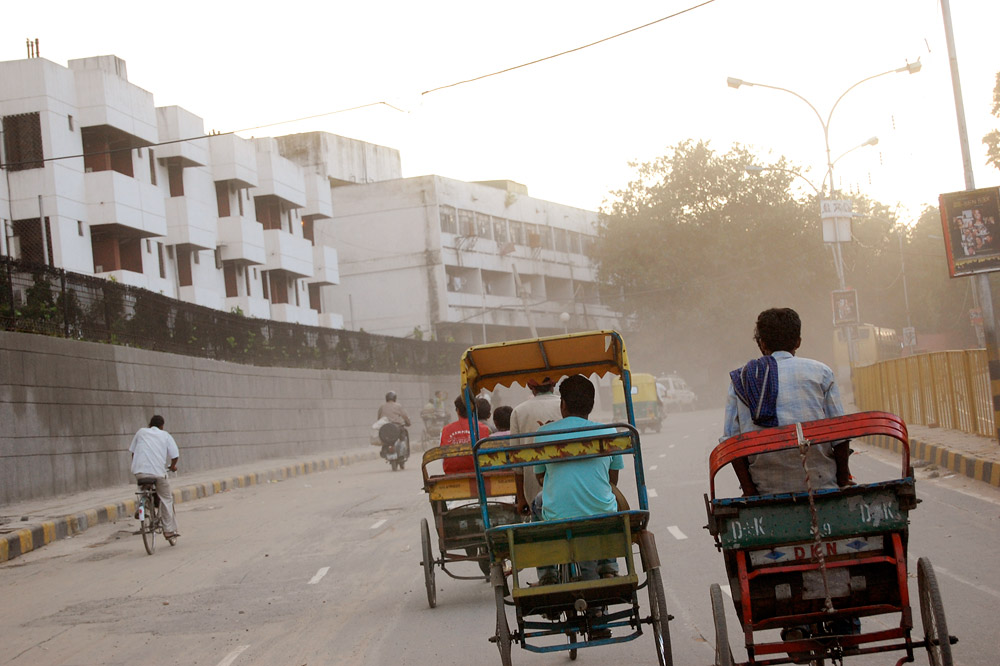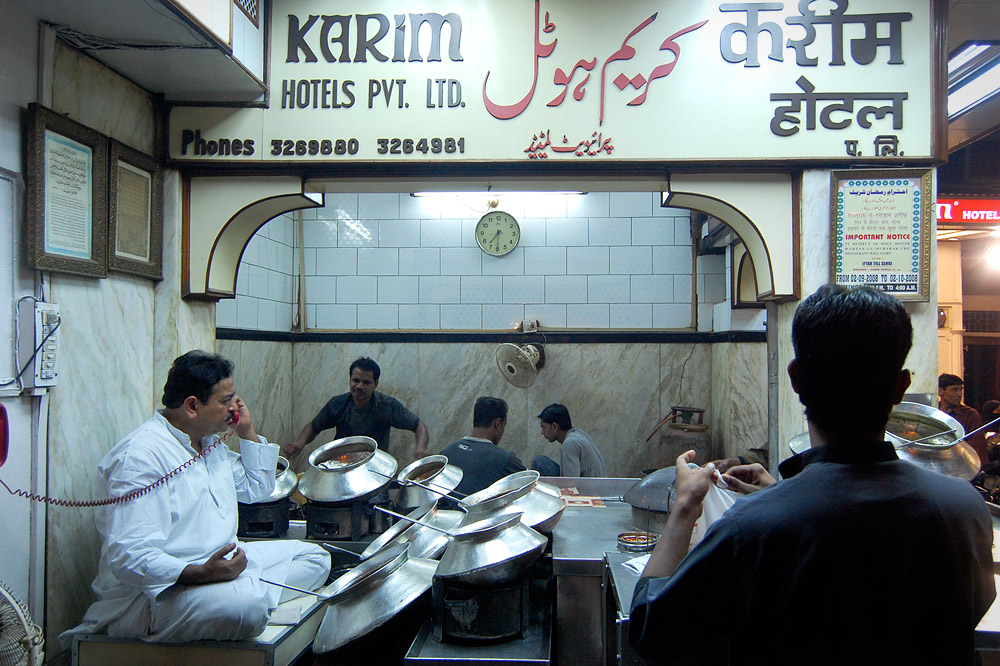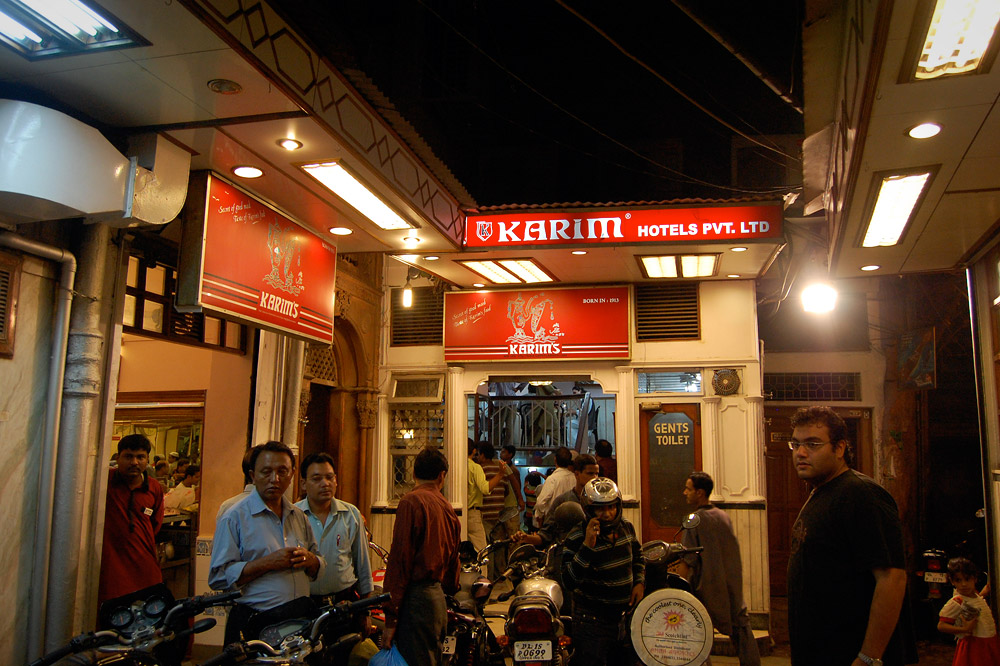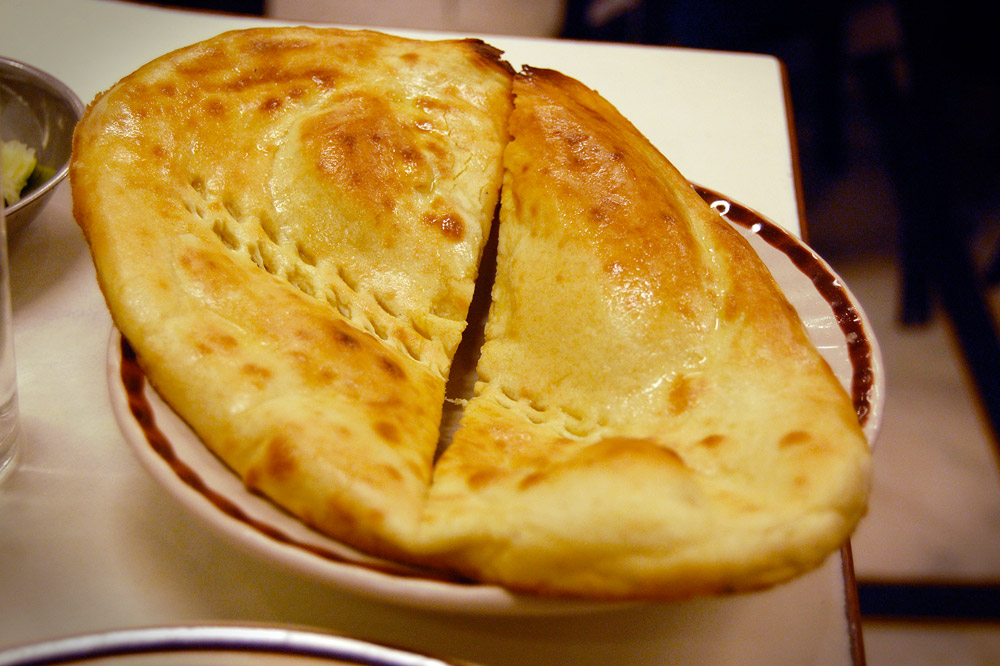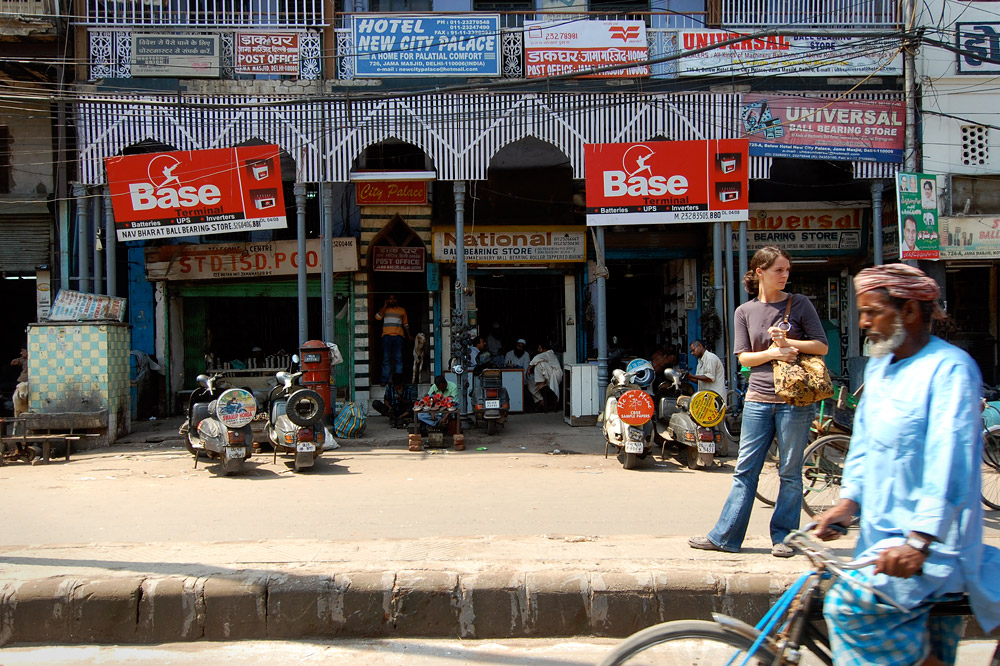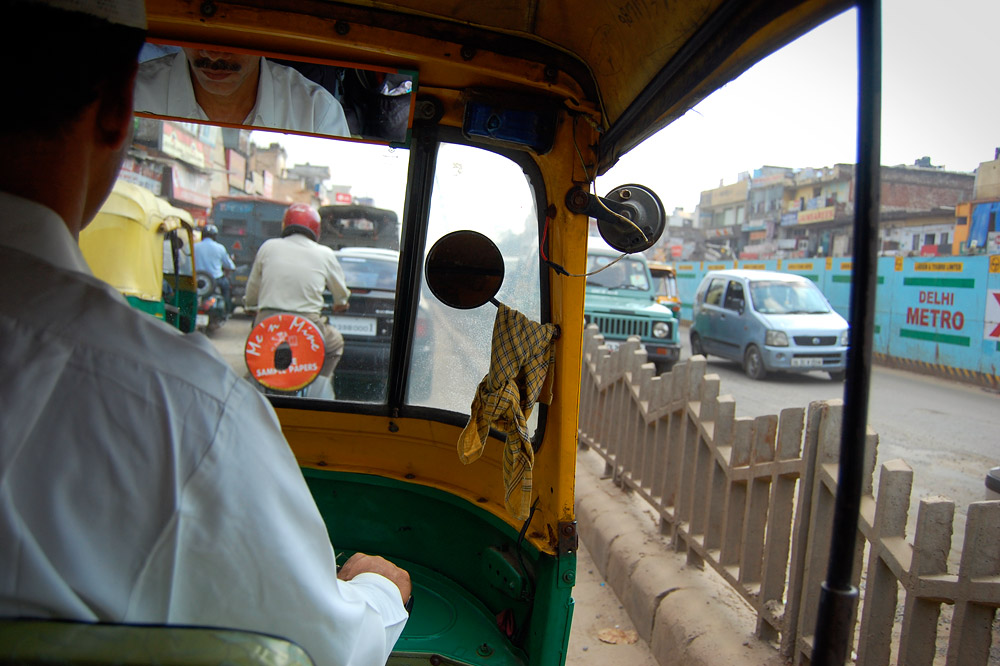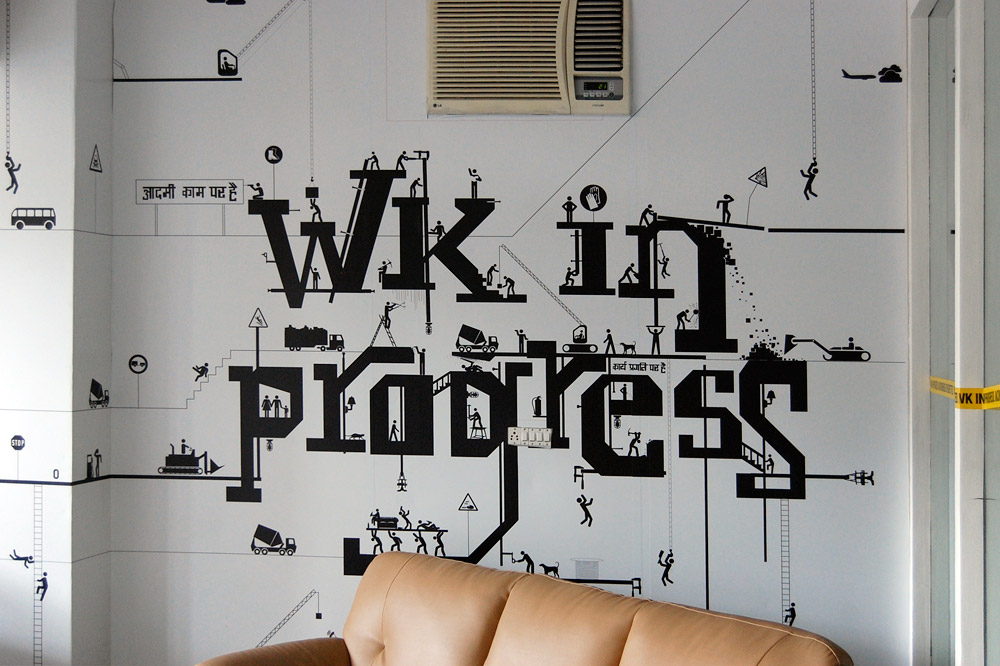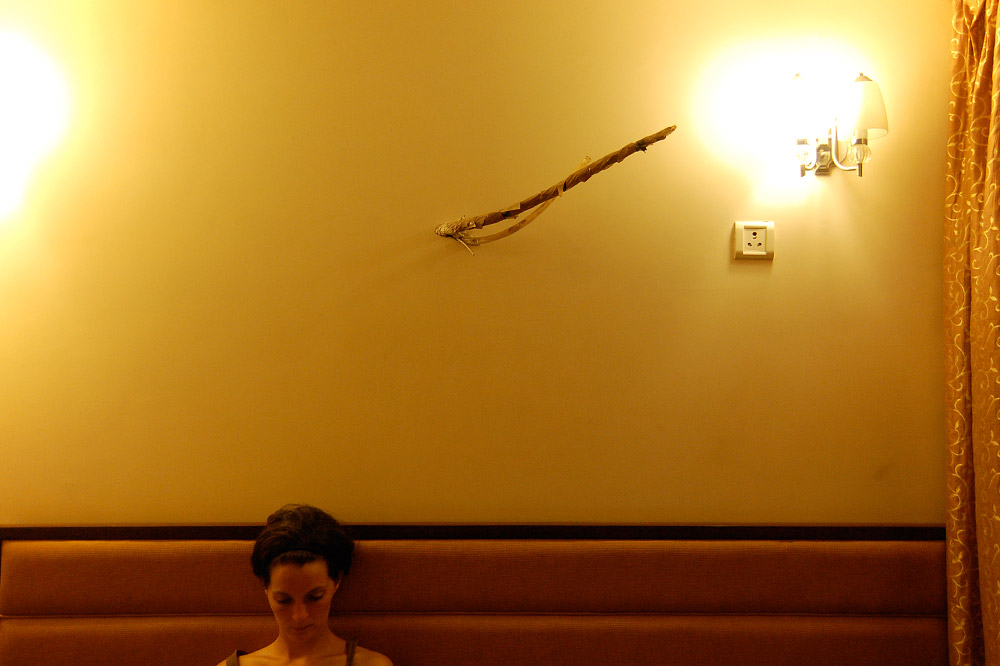Two Days in Delhi, India
J. and I arrived in Delhi, India on Saturday evening. We didn’t have a place to stay as the hotels I called kept hanging up on me. We decided to head deep into the heart of Old Delhi and try our luck at what would turn out to be a non-existent place called Hotel Bombay Orient. At the airport it was unclear where the credible taxi stand was. We found it, but still got a shifty little Indian duo. One man sat up front with the driver, telling him expressive stories in Hindi. The driver listened, responding when necessary. The whole time he was guiding the aged, heavy black and yellow cab through mind-blowing insane traffic. Weaving, dodging potholes, parked cars, cars crossing traffic, pedestrians, cows. Honking the horn at the slightest doubt of being seen. Getting honked at. Fitting between busses and cars. Choking on smoke and dust. I have never seen more chaos on the road. The prepaid fare was around $8.
The driver couldn’t find our destination, nor did he try very hard. The whole area near the Jama Masjid Mosque is named after the the mosque. Eventually, we were able to loosely determine where we were. J. and I got out of the cab into the swirling, foul-smelling street and tried to avoid giving the driver a tip. His buddy got out and walked after us. I gave him a dollar. He went away. We were on our own in the midst of chaos. With all our bags in tow, we walked purposefully down the busy road looking for minarets over the rooftops. The night was smelly and warm. The streets and people looked menacing. I was pouring sweat. We tried to not look lost. Through asking a few people, we backtracked, cut down another street and found our way. The area around the mosque was swarming with even more activity as Muslims celebrating Ramadan spilled out into the street to eat and go about their business. Goats, cycle rickshaws, motorbikes, tuk tuks crowded the street. Beggars and pilgrims were preparing to sleep on the sidewalk and under makeshift structures. Goats and chickens were getting cut up. The ground was covered with spit, pee, manure, garbage, mud, food scraps. We pushed through the crowds wearing our exoskeleton luggage.
I was overwhelmed.
The Bombay Orient didn’t exist. Our backup, Hotel New City Palace, was between used auto parts stores and up a narrow flight of steps that had a goat chewing on the bannister. We checked in. They needed a copy of our passports for legal reasons, so we gave them some copies we had made earlier. We went out to dinner and came back to settle in for the night. Almost immediately upon locking the door, the buzzer rang. I ignored it for a while but then there was a knocking and a man asking “hello?” in a stern voice. J. and I were scared. We thought that someone had followed us up the stairs. I asked the man who he was. He said he needed our passports. I asked again who he was. He was insistent. There was no peephole. I grabbed the large padlock from the door to use as a weapon. I opened the door. It was the manager. The real manager. The man who was there before was just an assistant. After a long Q&A about the legal obligations of running an Indian hotel, I gave him our passports to make copies and filled out the required fields of a huge guest register. I apologized for not trusting him. He seemed annoyed but understanding. It was time for sleep without sheets from inside our room above the bleating, beeping, yelling, and vehicular noise of the street below.
The next day:
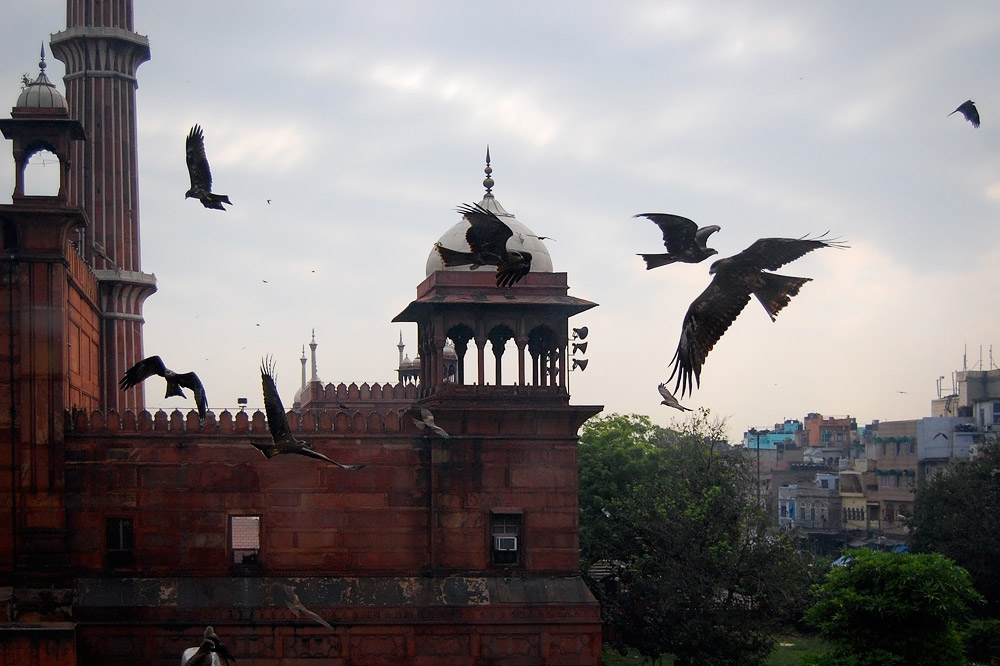
In the morning, I looked out our window and was surprised to see numerous predatory birds flying around. There were at least 50 in the area, and they were about twice the size as the already large crows. We would discover that these birds are all over town, particularly at the mosques.
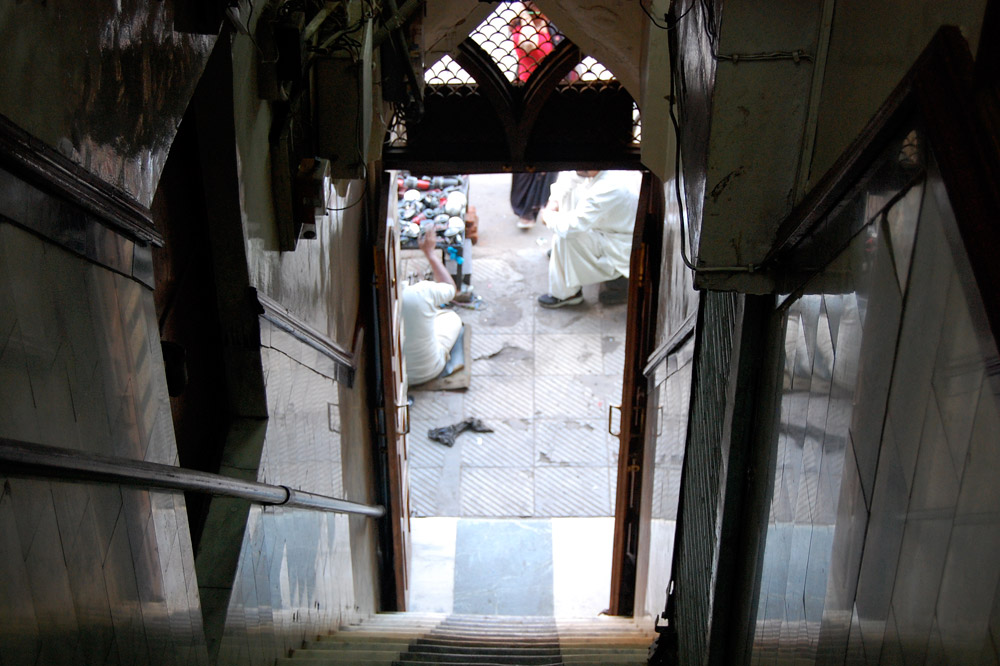
Descending onto the street from the hotel.
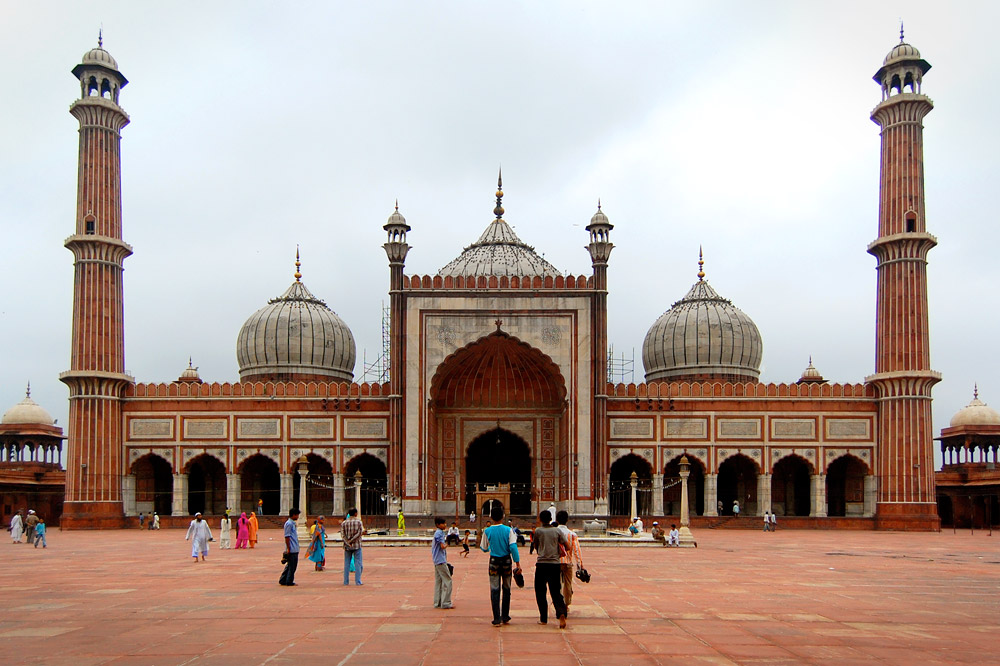
The central courtyard of Jama Masjid. It is said to be capable of holding 25,000, making it the largest mosque in India. It was built in 1644. Admission: free. Camera fee: 200Rs($4.5)
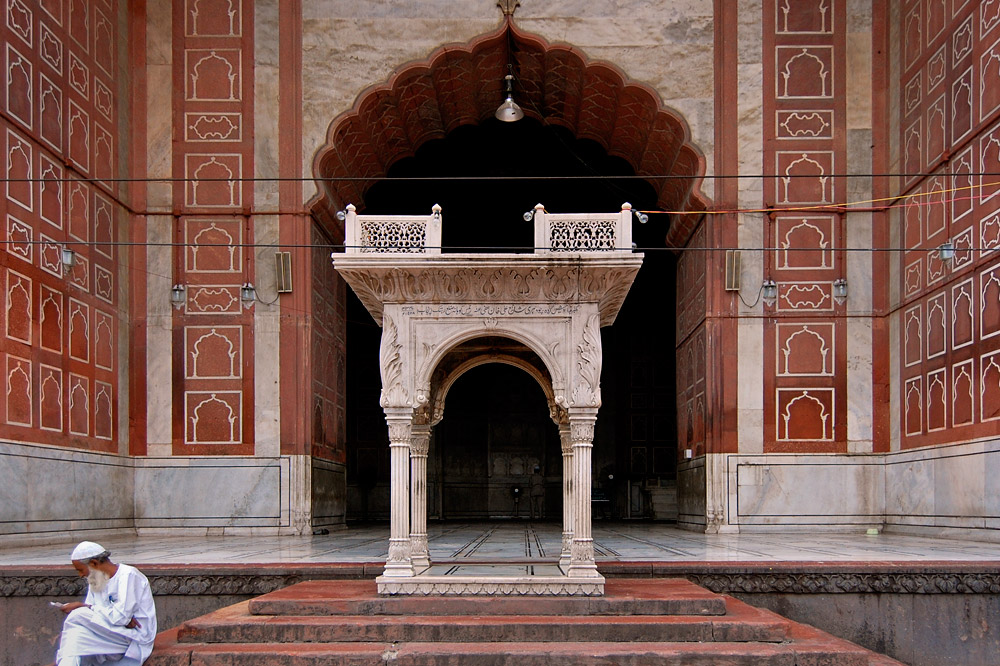
One of the wings with a man sitting on the steps.
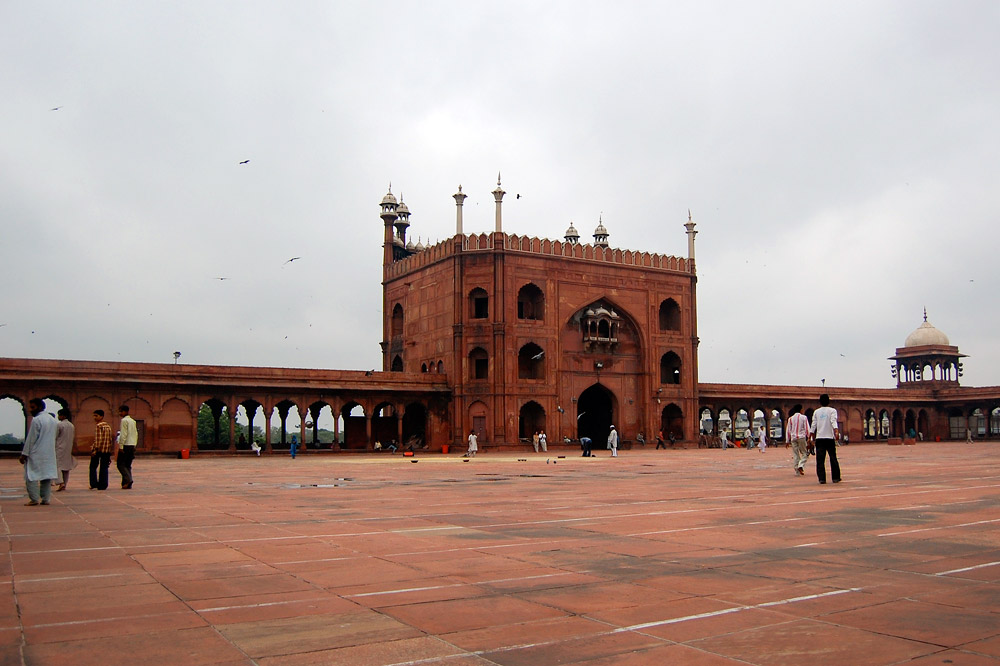
The main gate.
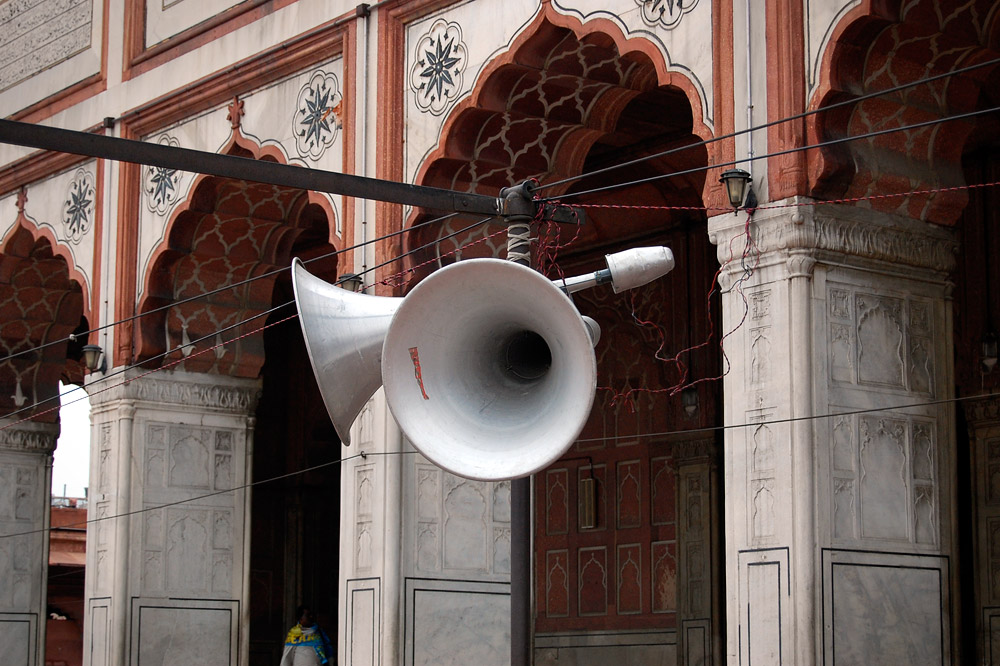
Prayer horns.
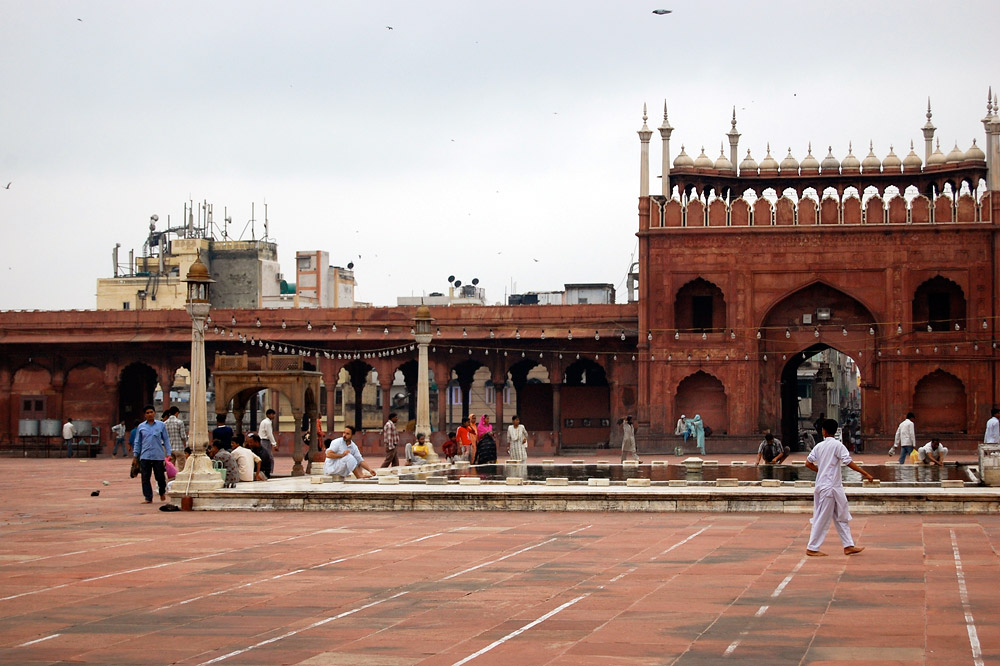
Cleansing pool.
The neighborhood.
We paid 50Rs($1+) each to climb one of the minarets. It afforded excellent views of the overcast city.
Poolside.
The colorful, crazy rooftops of Old Delhi.
Looking north to the other minaret.
The massive Red Fort in the distance.
Old-school lights in the minaret.
A grounds keeper sweeping seeds into a defined bird feeding area. I think these well-fed pigeons are the reason so many predator birds were hanging around.
Looking down the congested roads of Matya Mahal, one of the main shopping areas of the neighborhood.
Our hotel.
Hotel Naaz has fallen on hard times and even worse kerning, but it still looks cool.
J. in a shawl looking all National Geographic.
After sitting and people watching at the mosque, we headed north through smaller bustling streets to the main bustling street called Chandni Chowk. We hadn’t gotten used to everyone looking at us and the incessant “sir? sir?” of the rickshaw peddlers, but it was fun to walk through the thick of it. Men were getting lathered and straight shaved on the sidewalk. Firework stands were opening for business. More goats, cattle, street dogs lingered about. People were walking in mass, avoiding rubbish and cars and hocking up blood red spit from their betel nut and tobacco chews.
A colorful croud.
The Southern India platter from a great, clean restaurant called Haldiram’s. The platter was 88Rs($2).
A smaller mosque on Chandni Chowk.
Twenty monkeys were working their way down the street along the sides of buildings. No one seemed to notice.
Except for this man in blue who watched them pass his building.
The monkeys used the power lines to cross streets from above. The monkey on the right is named “The Butt”.
Beasts of burden on Chandni Chowk.
The intersection of two major roads near the main gate to the Red Fort.
The park next to the mosque was being used as an unofficial goat storage area.
A jam of bike rickshaws.
Rooftops over a market. Some had goats.
Peering into a cloth vendor’s stall.
This evil looking kid was eating scraps and head-butting his brother.
Nearby were butcher shops specializing in hacking up the live goats. Here’s a pile of heads.
After lunch, we walked back to Matya Mahal and browsed the madness for an outlet adapter. Here’s a view of the wiring overhead. Over a crowded counter, I haggled the price down to 15Rs(35¢).
Ground level river of people. Not pictured: motorbikes and rickshaws trying to weave down the middle, and succeeding.
We hired a rickshaw to take us to Raj Ghat. The little man peddled hard and steady. The trip there cost us about a dollar.
Tuk tuks.
Beverage stand.
Colorful transportation.
Snack vendor.
The look back.
Big bundles.
Elephant transport.
Cold water cart.
Tipsy microbus.
Raj Ghat is a large park south of the Red Fort. It’s simple black marble platform marks the spot where Mahatma Gandhi was cremated. There were a lot of school children visiting that day.
A few colorfully-dreshed Indians pay their respects.
Monument leaner.
A group of boys enthusiastically asked J. to take their picture. Afterward she high-fived one of them with her left “poop” hand and the boy asked her if she had washed it.
Heading back from Raj Ghat in the dust evening light.
A few desserts from Haldiram’s. They had a daunting amount of intriguing items on the lower floor. This box cost us 60+Rs. Lots of delicious nut flavor going on in these.
At the classy, cramped hotel we rested a bit, took a cold “shower” and headed out for a second dinner at an amazingly good restaurant nearby called Karim’s. It was a short walk down the lane from Jama Masjid’s south gate, in an alley. All of the buildings were part of the restaurant. There was a main cooking area, a few separate dining areas, and a meat loft where the waiters would call up order and get a muffled response from behind the racks of meat.
There was a tension in the air, and we were hurriedly seated. The fasting period was about to end, and soon a buzzer would sound and a flood of hungry Muslims would spill out of the mosque in search of their first food of the day.
The cooking area.
The alley and entrances to Karim’s.
Our meal looked like crap, but was delicious. We ordered two kinds of naan, tandori burra (roasted goat), a chicken curry, and a clove flavored rice dish, chutney. Each table was given a large platter of sliced red onion and lemon/lime slices to eat with the meal. The first night we went there, J. swung her arm and knocked a full glass of soda off the table. It shattered and soda dripped down the stairs. No one seemed to mind, but I was so ashamed I beat her severely that evening using a leg of mutton and faith in Allah.
The door to our hotel is on the left. A man is standing in it, talking on the phone and holding the leash of a goat. Around it are muslim owned auto parts stores piled high with oily merchandise.
That evening we slept poorly due to street noise, mosquitos, lack of sheets, and explosion sounds. I guess that’s what you get with a 400Rs($9) room on a busy street.
On Monday, we didn’t do much other than errands in the parts of town we had been the day before. Our first objective was to get a SIM card and credit for my phone. We found a reputable looking, English-speaking place. The SIM card and 100Rs in credit cost 450Rs($10). The credit is good for a year. Cell service is a much better deal here than it was in Thailand. We had to run back to the hotel to get a passport photo because for some reason law requires it (and copies of a passport) to get a SIM card. We went to lunch and found that our extra credit hadn’t been activated yet. We walked back to the store, he made a call, and we got our rupees. Relieved, we went and got lattes ($1 each) at a shiny new place on Chandni Chowk. From our air-conditioned chairs we watched the madness outside. People would look in at us with an expression of curiosity.
I was able to get a hold of one of the two bigwigs at Wieden + Kennedy India. We planned to meet around 2. The office was far from where we were, on the southern side of New Delhi near Qutab Minar. As we had a 5AM flight the next morning, J. and I decided to check into a hotel close to the airport and not far from the office. All of our bags went with us. The auto rickshaw ride there was exciting. The driver was surly but helpful. We passed through the bustle of Old Delhi to the bustle of Central and New Delhi. Traffic circles, triumphant gates, mansions, construction. The main road to the office was a dusty mess of subway construction. I didn’t take pictures.
Our auto-rickshaw driver skillfully took us the long distance across town. The ride cost a hefty 300Rs($7).
We weren’t exactly sure where the office was, so the cab dropped us off at the Qutab Hotel and we searched on foot. After about ten minutes and a sweaty conversation at a Honda dealership, I ended up calling my contact. We were in the right place. He appeared from behind me moments later. The office was a relaxed oasis. We talked about advertising and India for a little while. He fetched us two delicious cups of coffee and much needed water. He said we were free to use W+K India as a base for as long as we liked. We thanked him and stayed an hour to catch up on internet. He chartered a private car to take us to the hotel. Very generous. We thanked him again and were on our way. The advertising agency I left is a little like a family to me. As much of a family as a business can be.
Murals on the temporary walls of W+K India.
The mystery cable in our hotel room.
Our new hotel was in a cluster of development next to the highway that led to the airport. We checked in, paid our 850Rs($19) rate, took hot showers and went to bed. Our wake up call was at 2:45AM the next day. After just three hours of sleep, the ride to the Delhi domestic terminal was a fuzzy one. At that hour, only dusty military looking shipping trucks were on the road. Our flight was delayed an hour due to weather at our destination. It was time to leave Delhi; it was time to escape to Leh.


